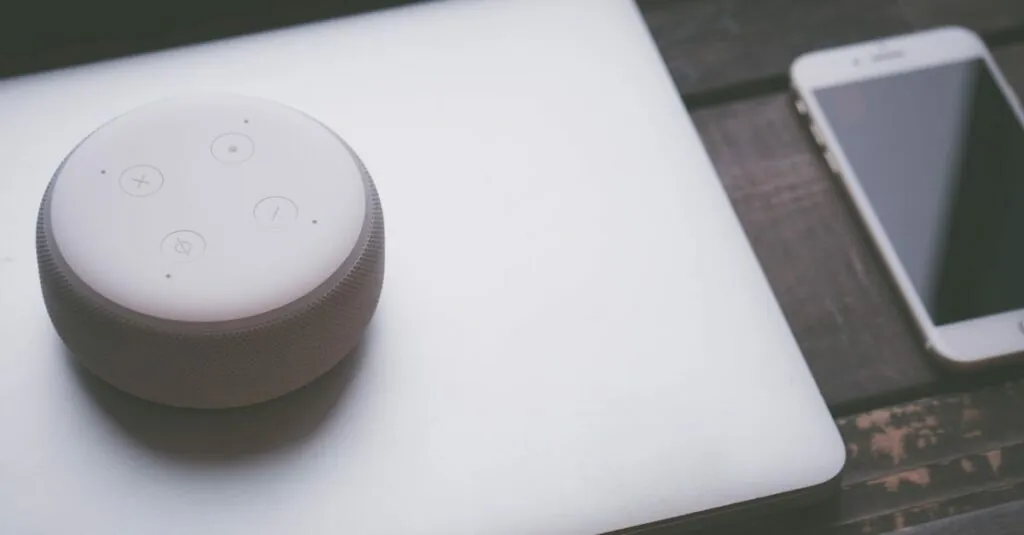Table of Contents
ToggleEver found yourself in a heated game of “Where’s Waldo” with your iPhone speaker? You’re not alone. Many users have been puzzled by the elusive location of this tiny powerhouse that brings music and calls to life. It’s almost as if Apple designed it to be a secret agent, hiding in plain sight while you frantically search for the perfect volume.
Overview of the iPhone Speaker
iPhone speakers are crucial for audio playback during calls, music, and notifications. Users typically find the primary speaker located on the bottom edge of the device. This placement allows for direct sound projection, maximizing audio quality.
Another speaker resides in the earpiece at the top of the iPhone. This earpiece speaker functions primarily for phone calls, providing clarity despite the device’s slim profile.
Some iPhone models also feature stereo speakers. The combination of bottom and earpiece speakers creates a rich sound experience. When using the device in landscape mode, the stereo effect significantly enhances media playback.
Apple continuously improves speaker technology across different iPhone models. Recent releases emphasize clearer sound, louder volume, and reduced distortion.
Users should check their iPhone settings for audio adjustments. Ensuring the volume is set appropriately prevents frustration during playback. Sound quality can also differ based on the environment, with soft surfaces absorbing sound waves and hard surfaces reflecting them.
By understanding the speaker locations, users can navigate their devices more efficiently. Familiarizing oneself with the iPhone’s audio capabilities unlocks the potential for an enhanced listening experience.
Location of the iPhone Speaker
The iPhone features multiple speaker placements for optimal audio performance. Understanding these locations enhances listening experiences.
Front Speaker Placement
The front speaker, also known as the earpiece speaker, sits at the upper edge of the device. This speaker primarily serves phone calls, providing clarity during conversations. Clear sound transmission occurs here, allowing users to hear their contacts clearly. Many iPhone models use this speaker in tandem with the bottom speaker for stereo sound. Users often notice that audio quality can vary based on their environment and how closely they hold the device to their ear.
Bottom Speaker Placement
The bottom speaker, located on the lower edge of the iPhone, plays a significant role in audio playback. It handles media such as music, videos, and notifications. Broad sound projection benefits from this placement, ensuring immersive listening experiences. Apple’s design often integrates enhancements, including stereo sound for select models. Users appreciate this speaker’s ability to deliver powerful audio, especially while watching videos in landscape mode. Checking audio settings can help ensure optimal performance from this powerful speaker.
Sound Quality of the iPhone Speaker
Sound quality significantly impacts the overall user experience on the iPhone. The device offers a dynamic audio output, whether during phone calls or when listening to music.
Comparison with Other Smartphones
iPhone speakers typically deliver superior sound quality compared to many other smartphones. Many competing devices struggle with distorted audio at higher volumes, while iPhone models maintain clarity even at loud settings. The use of stereo technology in newer models enhances hearing experiences, especially for multimedia content. Users often note that iPhones excel in bass response, lending depth to music and movie soundtracks. A balanced audio profile characterizes Apple devices, catering to various listening preferences effectively. Brands like Samsung and Google have improved their speaker technologies, yet iPhones often lead in audio balance and clarity. Users desiring an optimal auditory experience frequently choose iPhones for their reliable sound performance.
Troubleshooting iPhone Speaker Issues
Users can experience various issues with their iPhone speakers. Checking the volume settings often resolves many minor problems. If the volume is set low, increase it using the side buttons or the Control Center.
Sometimes, the speaker may produce no sound at all. Restarting the device may fix temporary glitches. If the issue persists, users should ensure that the device is not in Silent Mode. This feature mutes sounds, affecting calls and notifications.
Dust and debris can obstruct the speaker grills. A gentle cleaning can improve sound output. Users should also examine if any case or cover blocks the speaker openings. In certain cases, an incompatible accessory may reduce sound quality.
Network settings may interfere with call audio. Resetting network settings can restore audio functionality during phone calls. This step won’t erase personal data; however, it will remove saved Wi-Fi networks and passwords.
In addition, there may be software issues impacting audio. Users should check for system updates under Settings. Updating to the latest iOS version often resolves audio problems.
For persistent speaker issues, testing audio with headphones can help diagnose the problem. If sound works through headphones, the issue likely lies with the speaker itself.
Taking the device to an Apple Store for a professional diagnosis is advisable if users cannot identify the root cause. Technicians can perform detailed hardware checks and repairs.
Finding the iPhone speaker might feel like a challenge but understanding its placement enhances the user experience. With the primary speaker located at the bottom and the earpiece speaker at the top, users can enjoy clear audio for calls, music, and notifications.
Apple’s commitment to improving sound quality ensures that iPhones deliver superior audio performance compared to many competitors. By familiarizing themselves with the speaker locations and taking simple troubleshooting steps, users can enjoy an optimal listening experience. Whether it’s for music, calls, or notifications, knowing where the iPhone speaker is can make all the difference.




